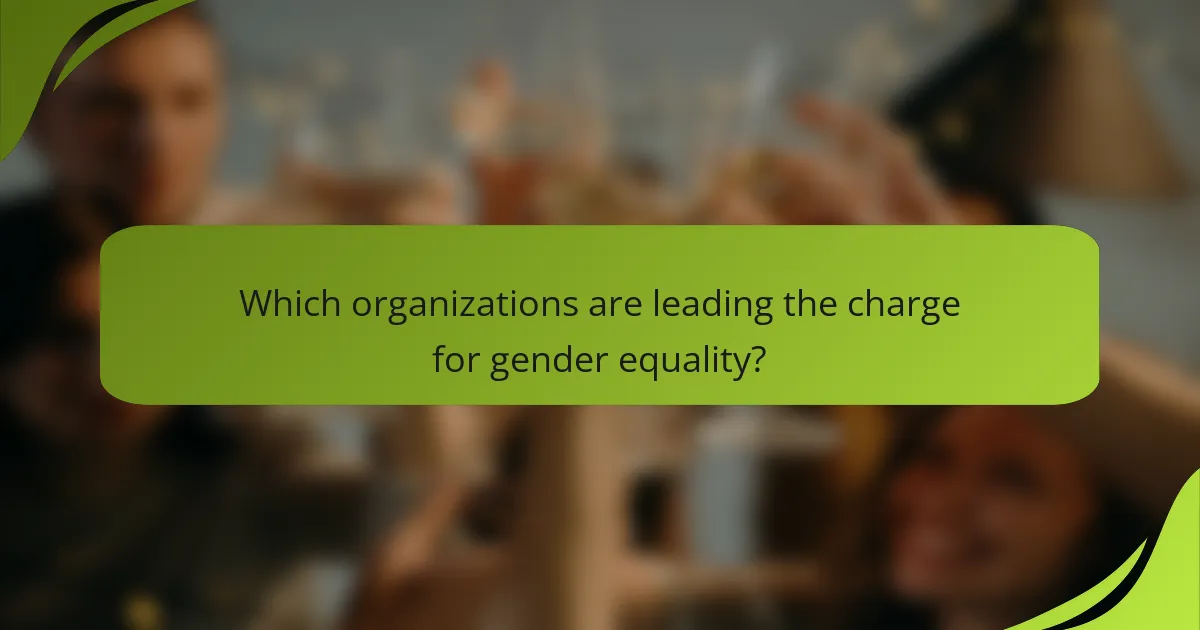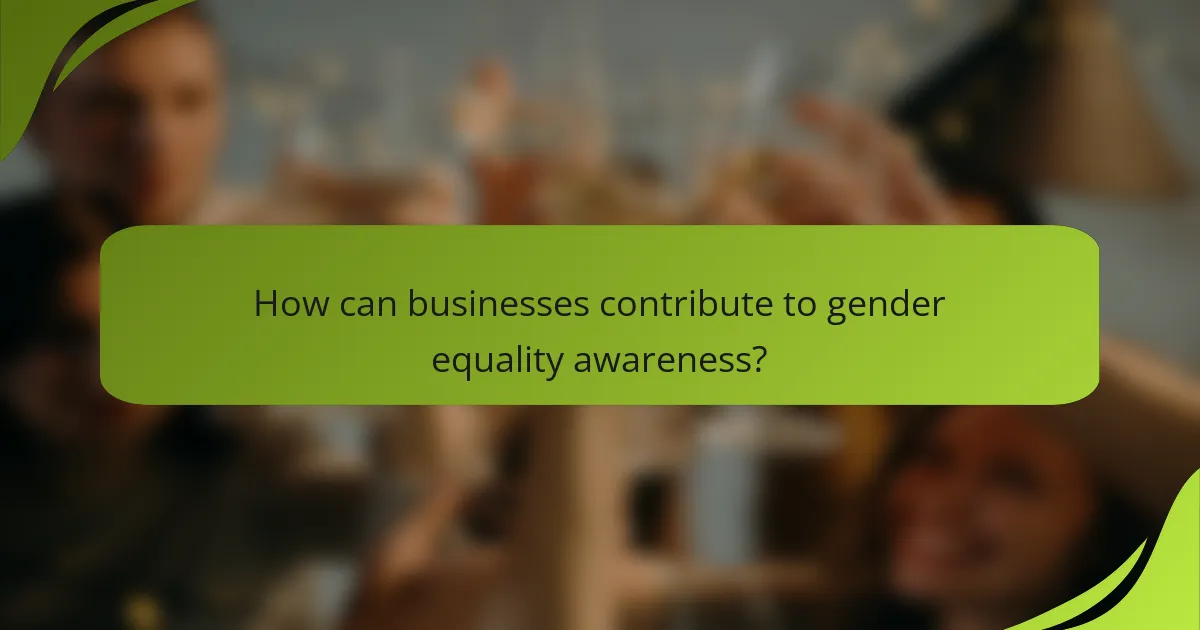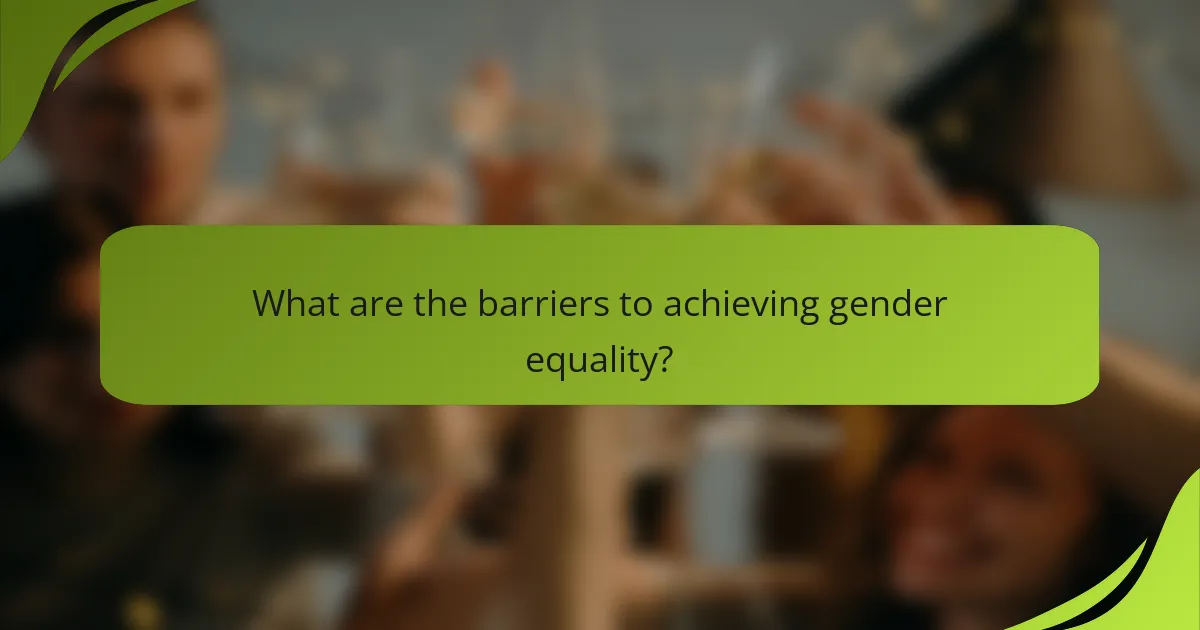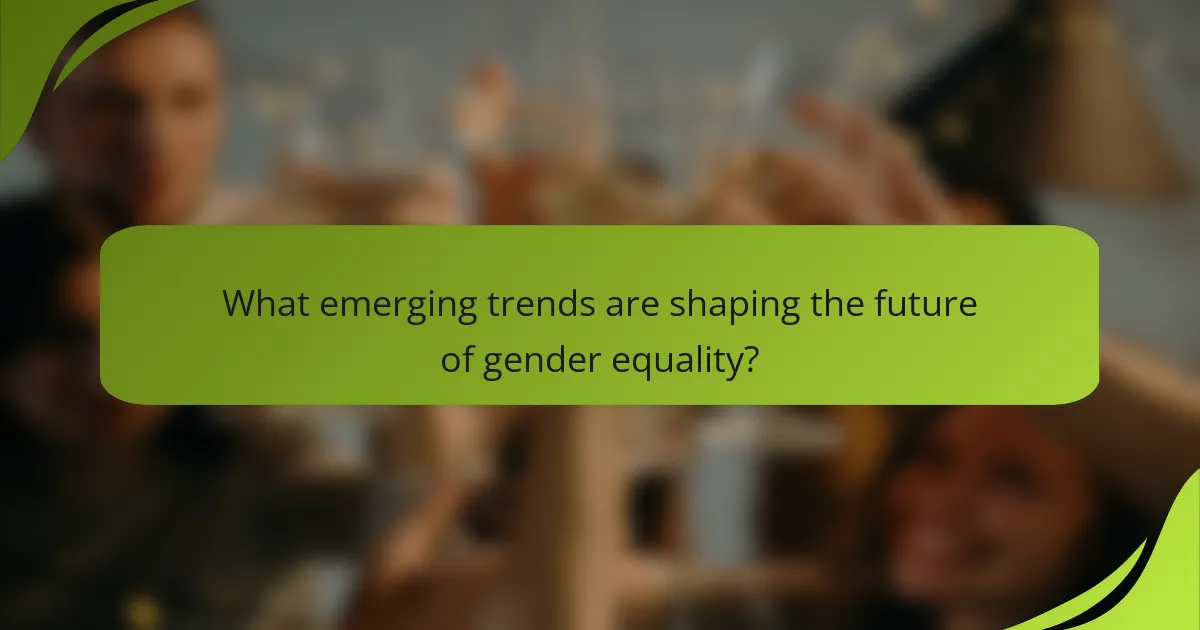The political climate in the United States plays a crucial role in shaping awareness and action surrounding gender equality. Legislative changes and shifts in leadership can either propel or obstruct progress toward achieving equal rights for all genders. By fostering community engagement and utilizing educational initiatives, advocates can enhance understanding and support for gender equality, ultimately working towards a more equitable society.

How does political climate affect gender equality awareness in the United States?
The political climate in the United States significantly influences gender equality awareness by shaping public discourse, legislative action, and societal attitudes. Changes in leadership and policy priorities can either advance or hinder efforts toward achieving gender equality.
Impact of legislation on gender equality
Legislation plays a crucial role in promoting gender equality by establishing legal frameworks that protect rights and promote equal opportunities. For instance, laws such as the Equal Pay Act and Title IX have been instrumental in addressing wage disparities and ensuring equal access to education for women.
However, shifts in political power can lead to the repeal or weakening of such laws. Recent years have seen debates over reproductive rights and workplace protections, which directly affect gender equality. Advocacy for new legislation is essential to counteract any regressions.
Public perception and activism trends
The political climate shapes public perception of gender equality, influencing how individuals and communities engage with the issue. Increased visibility of gender-related issues in political discourse can lead to heightened awareness and activism, as seen during movements like #MeToo and Women’s Marches.
Conversely, a hostile political environment may discourage activism and diminish public support for gender equality initiatives. It is vital for advocates to remain resilient and adapt their strategies to maintain momentum and foster a culture of equality, regardless of the prevailing political atmosphere.

What are effective strategies for promoting gender equality awareness?
Effective strategies for promoting gender equality awareness include community engagement initiatives, educational programs in schools, and social media campaigns. These approaches foster understanding, encourage dialogue, and mobilize support for gender equality in various settings.
Community engagement initiatives
Community engagement initiatives are vital for raising awareness about gender equality at the local level. They can include workshops, public forums, and collaborative projects that involve diverse groups, such as local businesses, non-profits, and community leaders.
To maximize impact, these initiatives should focus on addressing specific local issues related to gender inequality, such as domestic violence or workplace discrimination. Engaging community members in discussions and activities helps build a sense of ownership and commitment to gender equality efforts.
Educational programs in schools
Implementing educational programs in schools is crucial for instilling gender equality values in younger generations. These programs can include curriculum changes that incorporate gender studies, workshops on respectful relationships, and activities that promote empathy and understanding among students.
Schools can also partner with local organizations to provide resources and training for teachers, ensuring they are equipped to address gender-related topics effectively. Encouraging open discussions about gender roles and stereotypes can help dismantle biases early on.
Social media campaigns
Social media campaigns are an effective way to reach a wide audience and raise awareness about gender equality issues. Utilizing platforms like Instagram, Twitter, and Facebook allows organizations to share informative content, personal stories, and calls to action that resonate with diverse demographics.
To enhance engagement, campaigns should use compelling visuals and hashtags that encourage sharing and participation. Collaborating with influencers who advocate for gender equality can also amplify the message and reach new audiences, making the campaign more impactful.

Which organizations are leading the charge for gender equality?
Several organizations are at the forefront of advocating for gender equality, each playing a crucial role in promoting women’s rights and addressing disparities. These organizations work on various fronts, including policy advocacy, education, and community outreach, to create a more equitable society.
UN Women
UN Women is a global entity dedicated to gender equality and the empowerment of women. Established by the United Nations, it focuses on eliminating discrimination against women and ensuring their full participation in decision-making processes. The organization works with governments and civil society to develop laws and policies that promote gender equality.
Key initiatives include the HeForShe campaign, which encourages men to advocate for gender equality, and programs aimed at enhancing women’s economic empowerment. UN Women also monitors progress on gender equality globally, providing data and analysis to inform policy decisions.
National Organization for Women (NOW)
The National Organization for Women (NOW) is a prominent U.S.-based feminist organization that advocates for women’s rights through grassroots activism. Founded in the 1960s, NOW focuses on issues such as reproductive rights, equal pay, and ending violence against women. The organization mobilizes members to engage in lobbying efforts and public demonstrations.
NOW also emphasizes the importance of electing women to political office, believing that representation is key to achieving gender equality. Their campaigns often highlight the intersectionality of gender with race, class, and sexual orientation, ensuring a comprehensive approach to advocacy.
American Association of University Women (AAUW)
The American Association of University Women (AAUW) is dedicated to advancing equity for women and girls in education and the workplace. With a focus on research and education, AAUW provides resources and funding for programs that support women in STEM fields and advocate for equal pay. Their initiatives include fellowships and grants aimed at empowering women through education.
AAUW also conducts research on gender disparities in education and the workforce, producing reports that inform public policy and community initiatives. Their advocacy efforts aim to influence legislation that supports women’s rights and promotes educational opportunities for all.

What role do political leaders play in gender equality?
Political leaders play a crucial role in advancing gender equality through their influence, policy decisions, and advocacy efforts. Their commitment can significantly shape societal norms and drive legislative changes that promote equal rights and opportunities for all genders.
Influence of elected officials
Elected officials possess the power to shape public discourse around gender equality. Their statements and actions can either reinforce traditional gender roles or challenge them, impacting public perception and societal attitudes. For instance, when leaders publicly support gender equality initiatives, it can inspire similar commitments from businesses and communities.
Moreover, political leaders can leverage their platforms to highlight gender disparities and advocate for change. This visibility can mobilize public support and encourage grassroots movements aimed at achieving gender parity.
Policy-making and advocacy
Policy-making is a critical avenue through which political leaders can enact gender equality. By proposing and supporting legislation that addresses issues such as pay equity, reproductive rights, and workplace discrimination, they can create a more equitable environment. For example, implementing policies that mandate equal pay for equal work can significantly reduce the gender wage gap.
Advocacy efforts, such as forming coalitions with NGOs and community organizations, can amplify the push for gender equality. Political leaders who actively engage in these partnerships can help ensure that gender issues remain a priority in legislative agendas and public funding decisions.

How can businesses contribute to gender equality awareness?
Businesses can play a significant role in promoting gender equality awareness by implementing targeted strategies that foster inclusivity and support. This involves creating initiatives that not only raise awareness but also actively engage employees and the community in discussions about gender issues.
Corporate social responsibility initiatives
Corporate social responsibility (CSR) initiatives can effectively enhance gender equality awareness by aligning business practices with social values. Companies can support local organizations that advocate for gender equality, sponsor events that promote women’s rights, or engage in community outreach programs that educate the public on gender issues.
For example, a business might partner with a nonprofit to fund workshops focused on women’s empowerment or provide scholarships for women pursuing education in male-dominated fields. These initiatives not only raise awareness but also demonstrate a company’s commitment to social change.
Diversity and inclusion programs
Diversity and inclusion programs are essential for fostering a workplace culture that values gender equality. Businesses should implement training sessions that educate employees about unconscious bias and the importance of diverse perspectives. This can help create an environment where all employees feel valued and empowered.
Additionally, companies can establish mentorship programs that connect women with leaders in their field, providing guidance and support for career advancement. Regularly reviewing hiring practices and ensuring diverse candidate pools can also enhance gender representation within the organization.

What are the barriers to achieving gender equality?
Barriers to achieving gender equality include cultural norms, economic disparities, and institutional biases that hinder progress. These obstacles can manifest in various ways, affecting women’s rights, opportunities, and overall societal status.
Cultural and societal norms
Cultural and societal norms often dictate gender roles that limit women’s participation in various sectors. For example, traditional views may prioritize men as breadwinners, discouraging women from pursuing careers or leadership positions.
These norms can perpetuate stereotypes that affect women’s self-perception and societal expectations. Communities may resist changes that promote gender equality, making it essential to engage in awareness campaigns that challenge these outdated beliefs.
Economic disparities
Economic disparities significantly impact gender equality, as women often earn less than men for similar work. In many countries, the gender pay gap can range from 10% to 30%, depending on the industry and region.
Additionally, women may face barriers to accessing financial resources, such as loans or property ownership, which limits their economic independence. Addressing these disparities requires policy changes that promote equal pay, support for women entrepreneurs, and access to education and training programs.

What emerging trends are shaping the future of gender equality?
Emerging trends in gender equality are increasingly influenced by social movements, technological advancements, and policy changes. These factors are reshaping workplace dynamics, public perceptions, and legislative frameworks, driving progress toward equality.
The role of technology in promoting gender equality
Technology plays a critical role in advancing gender equality by providing platforms for advocacy and education. Social media campaigns can amplify voices and raise awareness about gender issues, while online resources offer access to information and support networks.
Additionally, technology can enhance workplace flexibility through remote work options, which may benefit individuals balancing family responsibilities. Companies that leverage technology for inclusive practices often see improved employee satisfaction and retention.
Impact of social movements
Social movements, such as #MeToo and Time’s Up, have significantly impacted gender equality by bringing attention to issues like harassment and discrimination. These movements encourage individuals to speak out and hold organizations accountable for their policies and practices.
As a result, many companies are reevaluating their workplace cultures and implementing training programs aimed at fostering inclusivity. This shift not only promotes gender equality but also enhances overall workplace morale and productivity.
Legislative changes and their effects
Legislative changes are crucial in shaping the landscape of gender equality. Governments worldwide are enacting laws aimed at closing the gender pay gap, increasing parental leave, and ensuring equal representation in leadership roles.
For example, countries like Sweden and Iceland have implemented policies that mandate equal pay and promote parental leave for both parents. These legislative measures create a framework that supports gender equality and encourages other nations to follow suit.
